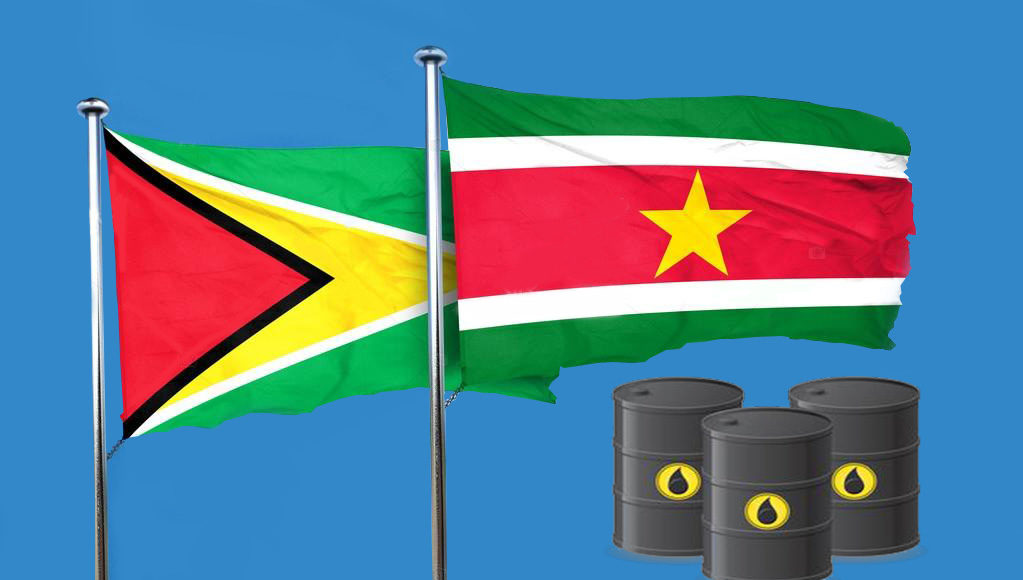Five years after Guyana’s first oil discovery and just weeks after production started last December, Suriname experienced a game-changer with its first offshore discovery at Maka Central-1. This was closely followed by two other discoveries – Sapakara West-1 and Kwaskwasi-1. While Guyana is ahead in terms of the number of discoveries made offshore – 21 to date – Suriname has more industry experience, being an onshore producer since the 1980s complete with its own state oil company – Staatsolie.
Guyana’s discoveries at the Stabroek Block, numbering 18, amount to more than 8 billion barrels of oil equivalent resources while, according to US multinational investment bank and financial services company Morgan Stanley, Suriname’s Block 58 contains a potential 6.5 billion barrels. The US Geological Survey (USGS) has said since 2001 that the Guyana-Suriname basin could contain an estimated 15 billion barrels of oil equivalent resources.
As oil companies shut in operations around the world under pressure from months of declining demand, plummeting oil prices, and a global economy in recession triggered by the pandemic, the Guyana-Suriname basin has remained one of the few locations where offshore operations remain in play and future projections look favorable.
Oil and gas companies continue to fold under severe pressure even as Guyana offshore blooms
“Oil supply in 2020 is forecast to decline mainly in the US with 1.0 mb/d, Russia with 1.1 mb/d, Canada, Kazakhstan, Malaysia, Colombia and Azerbaijan, and projected to grow in Norway, Brazil, Guyana and China,” the Organization of the Petroleum Exporting Countries (OPEC) said in its latest World Oil Outlook. The oil cartel said only a small number of non-OPEC producers show meaningful supply growth post-2025. “[These] include Canada, Qatar, Kazakhstan and Guyana.”
Suriname is aiming to join this group as production from its offshore fields come online. The country is also looking to fast-track this process.
Liza and Kwaskwasi are giants in the prolific Guyana-Suriname basin
“Although one of the fastest in the world, we expect a similar development as with the Liza discovery in Guyana. Five years after the discovery Guyana started production,” Moensi-Sokowikromo, Staatsolie’s Finance Director told OilNOW in August.
“While we have a lot more work to do, a discovery of this quality and magnitude merits a pace of evaluation that enables the option of accelerated first production,” John J. Christmann, Apache’s CEO and President, said at the time the Kwaskwasi-1 discovery was announced. Apache is the operator at Block 58 where Suriname’s three discoveries were made.
Norway-based Rystad Energy said offshore activity in Latin America is expected to recover from 2021 with more than 3 million barrels per day of peak production estimated to be sanctioned in Brazil and Guyana alone by 2025. “Of this, more than 80% of the capacity has breakeven prices of less than $45 per barrel and is expected to get sanctioned despite the current market environment.”
Guyana’s fiscal terms for the Stabroek Block together with high quality crude discoveries have made it feasible for operator ExxonMobil, and its co-venturers Hess and CNOOC, to forge ahead with their offshore operations.
“I have spoken to several people in the industry…they shared the view that Exxon wants to invest in Guyana because of the quality of the oil and the low breakeven cost to take it out, and they will make money here, given the fiscal conditions too,” Bharrat Jagdeo, Guyana’s Vice President, told reporters at a press conference this month.
For investors looking at this highly prospective basin, where to plug capital will come down to the cost of doing business and considerations such as the legal and regulatory framework, security, respect for the rule of law, and political stability.
With new governments recently being sworn in within weeks of each other in both Guyana and Suriname, the two countries now have a new lease on life and an opportunity to significantly accelerate their development with revenues from the multi-billion-barrel oil resources being discovered offshore.
Oil spurring hope and strengthening bond between two of South America’s smallest nations
Officials in both countries have said their respective governments are keen on ensuring that benefits to their people are maximized from the development of these resources.



